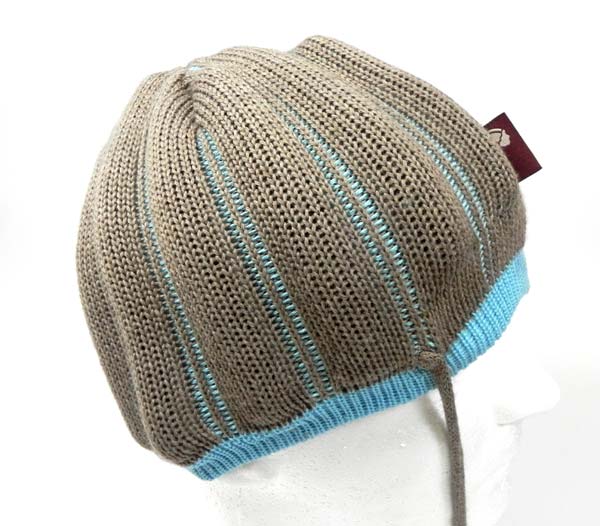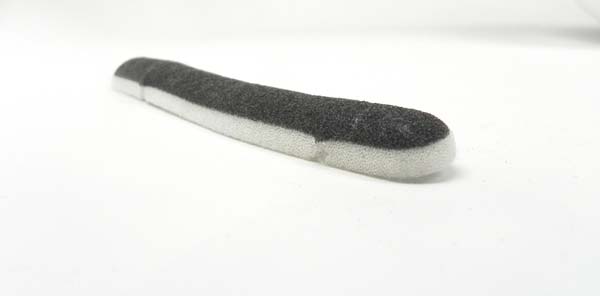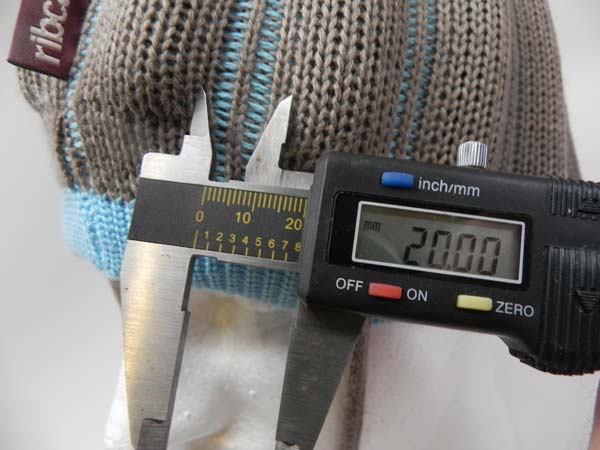Ribcap
Summary: As the manufacturer makes clear, the Ribcap padded cap is not a helmet, does not have the protection of a helmet, does not meet any helmet standard and offers minimal padding when you hit. But the aura of "protection" in the company's advertising and references to testing and a CE mark could distract you from that.
Ribcap is a knit wool and acrylic cap with thin foam inserts.
 The foam is only about 11mm thick and 20mm wide.
The foam is only about 11mm thick and 20mm wide.
 When the cap is stretched on the head, there can be 20mm
of gap between the foam fingers.
When the cap is stretched on the head, there can be 20mm
of gap between the foam fingers.  It should be apparent
at first glance that it does not offer helmet-like impact protection. The foam is very thin compared to a helmet's liner,
and is squishy slow rebound foam, not crushable helmet foam. And in fact the Swiss manufacturer says that up front. If
you read the label in the cap, it says "Product protects against minor impacts which do not affect vital head areas
(bumps, grazes and bruises). Warning: no protective effect like a helmet." That seems very clear. And the website says
"Note: RIBCAP® is not certified as a sports or riding helmet (such as skiing, skating, cycling, ... etc.)."
It should be apparent
at first glance that it does not offer helmet-like impact protection. The foam is very thin compared to a helmet's liner,
and is squishy slow rebound foam, not crushable helmet foam. And in fact the Swiss manufacturer says that up front. If
you read the label in the cap, it says "Product protects against minor impacts which do not affect vital head areas
(bumps, grazes and bruises). Warning: no protective effect like a helmet." That seems very clear. And the website says
"Note: RIBCAP® is not certified as a sports or riding helmet (such as skiing, skating, cycling, ... etc.)."But after stating that the cap is not a helmet, Ribcap's website goes on to tout various elements that could prove distracting:
- Ribcap says the polyurethane foam is a high-tech product. They also say the molecular structure of the foam can
be cross-linked with electron bombardments, but not that the foam version they use has actually been processed with
electron beams. The foam manufacturer says their line "includes" rate-sensitive foam that stiffens up with harder
impacts. But you cannot repeal the laws of physics. The thickness of the material always determines how fast you have
to stop the head. The foam in the Ribcap is too thin to do the job of a helmet. The head just has to stop too fast.
- The manufacturer shows the product in use by, or says it is suitable for skiers, bicyclists, alpine climbers,
mountain guides, snow boarders, ice skaters, paragliders and horse riders. But they don't say the cap has been tested
to any bicycle, ski or equestrian standard. As a bike helmet it could not legally be sold in the US because it does not
meet our bike helmet standard, but according to the manufacturer's web page it is being sold in European bike
shops.
- The manufacturer's web page has a statement:
"Ribcap has been tested under Regulation 12, Law 4, Designation: IBR/REG12/Iss1/2005 Standard Performance Specification for Specific items of players' Clothing."
We don't know what that standard is, but the statement above that the Ribcap is not certified as a sports helmet says it all.
Dr. Rémy Willinger of the University of Strasbourg evaluated samples of foam of the type used in Ribcaps and stated in his extensive technical report that it provided some protection in all the test situations where he tried it. But he did not test actual Ribcaps, and his report does not say whether the foam samples he did test were the same thickness and density as production Ribcap foam inserts. The reader may not realize that the drop tests were all at lower levels than helmet testing, and the headforms used were not helmet test headforms, but an automotive headform designed for car crash testing. Even so, the resultant g levels were all substantial. Putting almost any foam on the anvil would of course reduce those g levels, if only by a g or two. But testing an actual cap would risk hitting between the fingers, where only wool fabric would be between headform and anvil.
The manufacturer formerly labeled the Strasbourg report "certification" and when you clicked on that word they had a short form of the report on their web page as the technical underpinnings of their claims for protection. And they quoted Dr. Willinger "Ribcap prevents head trauma- Heads protected by Ribcap show up a significantly lower injury risk in all tested impact configurations" Ribcaps prevent head trauma? He did not test any actual Ribcaps for the report. There is an appearance here of having conducted a serious investigation of the protective capabilities of the foam used in the caps, but only at low velocities on a flat anvil. Really protective headgear is tested at higher drop heights, using less-forgiving metal headforms and on hemispheric or curbstone anvils as well as flat. The actual headgear is tested, not a sample of the materials in it. So there is no actual test of the caps, and no comparison anywhere of the caps' performance with that of helmets meeting actual helmet standards.
For more, see Ribcap's web page.
The Guardian article
In May of 2011 a blog writer for the UK's Guardian endorsed the product, and the editors not only used the headline "Ribcap folding bike 'helmet' - review" but mislabeled a photo as "Helen Pidd wearing a Ripcap foldable bicycle helmet." They did not even spell the product name correctly. And the author says she is going to "review the very cosy cycle helmet I've been rocking all winter on the streets of Berlin." Confusion reigns at the Guardian. The caps are not helmets. This article illustrates how the manufacturer's advertising can be distracting and clearly the Guardian was misled.
Bottom line
If you want to wear a Ribcap rather than a helmet, that's up to you, but we hope you do not confuse the level of protection offered by the product with the protection of a helmet. For that you have to wear a helmet with a sticker inside saying it meets the standard for the sport you are engaged in. The testing to meet that standard is based on impacts you can reasonably expect. We think that settling for less is cheating yourself of the protection your brain deserves.
For a hat-style helmet that meets the CEN European bike and skateboard helmet standard, see the Danish Yakkay or the Lazer CityZen. You don't have to settle for less to have a real helmet that looks like a cap or hat.
For more on the protection offered by non-traditional headgear, see our page on turbans. Some of them would probably out-perform the Ribcap in an impact test.
Back to the top
Back to the Home Page